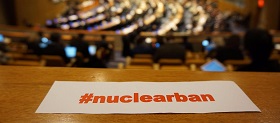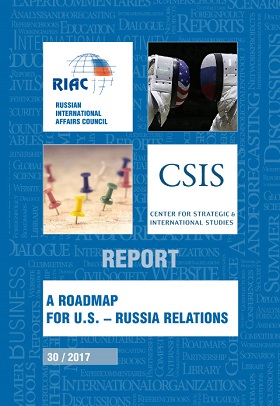MAD's Midlife Crisis: The Impact of US-Russia Rivalry on International Arms Control
(votes: 5, rating: 4.8) |
(5 votes) |
MSc in International and European Studies, Associate Political Affairs Officer at the UN Office of the Special Envoy for Syria
The Ukrainian crisis, which led to the deepest confrontation between Russia and the US since the end of the Cold War, provided justification for increased levels of military activity for both sides. Since 2014, large-scale combat readiness exercises conducted by Russia on its territory and by NATO members close to Russian borders, each directed against each other, have rapidly intensified. And every step in the further escalation of tensions by both parties has been a reaction — under the pretext of the opponent having intensified its own military activity first. Irreconcilable narratives and threat perceptions, coupled with broken channels of communication — most notably, the NATO-Russia Council — have led to mutual allegations in non-compliance with almost all arms-control agreements. The limits of this chapter do not allow us to examine in depth all compliance disputes concerning the implementation by Russia and the US of disarmament treaties and bilateral agreements. However, in our opinion, the review of major compliance disputes will help better understand the background of US-Russian confrontation narratives, as well as the interconnectedness of different disarmament issues and starting points for negotiations in disarmament settings. In the second part of our analysis we will examine the differences in the Russian and US approaches for strengthening regimes against weapons of mass destruction (WMD). We will also examine the major dividing lines and assess whether there is a risk of erosion of current disarmament regimes, or whether these offer an area for rapprochement and agreement.
Russia and the United States: mutual allegations in non-compliance with nuclear disarmament treaties and bilateral arms control agreements
The compliance disputes concerning the INF Treaty
The Intermediate-Range Nuclear Forces Treaty (INF Treaty), signed between the United States and the Union of Soviet Socialist Republics in 1987, required both countries to eliminate all of their nuclear and conventional ground-launched ballistic and cruise missiles with ranges of 500–5,500km. The two sides eliminated 2,692 short-, medium- and intermediate-range nuclear-armed missiles by 1991 — the first time ever that an entire class of nuclear weapons has been eliminated. In July 2014, the US State Department officially alleged that the Russian Federation was violating the INF Treaty by conducting flight tests of a ground-launched cruise missile with a range that is prohibited by the treaty. Since then, Russia has repeatedly denied the accusations, and has accused the United States of deploying defense systems in Romania and Poland which could potentially be used to deploy Tomahawk cruise missiles with a range of up to 2,500 km. Indeed, in May 2016, the United States placed into operation the Aegis Ashore Ballistic Missile Defense System in Romania equipped with Mk-41 launchers, with a similar system scheduled to be completed in Poland by 2018. Russia has also repeatedly accused the US of producing and deploying armed drones that are equivalent to ground-launched cruise missiles. In early October 2016, Russia deployed short-range, nuclear-capable Iskander-M ballistic missiles in the Kaliningrad region, the westernmost territory of Russia, as part of its regular military maneuvers. Officials in Washington and Moscow have accused each other of provocations with these deployments which are designed for or capable of undermining the other party’s deterrence capabilities.
Despite the heated rhetoric, up to now neither the US nor Russian allegations indicate that Russia or the United States currently plans to withdraw from the INF Treaty. On 11 October 2016, in his statement on the occasion of the 30th anniversary of the Reykjavik Summit, US Secretary of State John Kerry reiterated that the vision of Reykjavik was still alive today and urged Russia to return to compliance with the INF Treaty. As for the possible Russian withdrawal from the INF Treaty, according to the Russian expert Petr Topychkanov, the action-reaction chain initiated by such a withdrawal would “lead to growing missile threats to Russia in Europe and to further erosion of the arms control regime, if not its total destruction, which is not in Moscow’s interest.” In our opinion, one of the options to settle these disputes could be to engage in confidence-building measures as per the existing provisions under the INF Treaty. It is worth recalling that Article VIII provides for a Special Verification Commission (SVC) to act as an implementation body for the treaty, resolving questions of compliance and a dispute-resolution mechanism. As the INF Treaty is of unlimited duration, States Parties can convene the SVC at any time. On 15-16 November 2016, the 30th session of the SVC took place in Geneva and delegations from Russia, Belarus, Ukraine, Kazakhstan and the United States discussed issues related to implementing the treaty. The convening of a meeting of the SVC for the first time since 2003 could be a strong sign of the commitment by Russia and the US to resolve the existing dispute through negotiations rather than threats of withdrawal from such an important treaty.
Russian concerns over the compatibility of NATO nuclear-sharing practice with the provisions of the NPT
Another long-standing compliance dispute between Russia and the US is the issue of NATO nuclear-sharing and the perceived incompatibility of this practice with the provisions of the NPT. According to the understanding of Russia, NATO nuclear-sharing violates Articles I and II of the Treaty: Article I prohibits nuclear-weapon states that are parties to the NPT from transferring their weapons to non-nuclear states, and Article II prohibits non-nuclear states receiving nuclear weapons. The question of whether the treaty applies in times of war is a very crucial one to the interpretation of the legality of nuclear-sharing. According to the US interpretation of the NPT, the treaty does not apply in times of war. It means that the non-nuclear NATO partners in effect become nuclear powers in time of war. Following this logic, nuclear-sharing is legal (or at least not explicitly prohibited in the NPT) in times of war. According to the publicly-available data, NATO’s system on nuclear-sharing currently provides between 160 and 200 tactical nuclear weapons (B-61 warheads) with an overall capacity of 18 megatons stored inside six air base vaults across Europe. Stockpiling of US tactical nuclear weapons (TNW) outside the territory of the US has for a long time been a stumbling block in US-Russia bilateral disarmament negotiations. The situation was further exacerbated when the US unveiled its plans to modernize its tactical nuclear arsenal in Europe. The new US weapon, the B61-12, is intended to replace all its older versions and is capable of destroying more targets with increased accuracy and consequently with limited damage to structures and lives nearby. It will be a “smart” bomb which can be guided to hit its target with great precision using exactly the right amount of explosive yield to only destroy what needs to be destroyed. That is why some military experts call these new warheads more “ethical”, stating that their use would have less severe humanitarian consequences. From Moscow’s view, the planned modernization of the US bombs could drop the threshold of using nuclear weapons when US nuclear bombs in Europe could become “battlefield weapons”.
As a result of NATO enlargement up to Russia’s borders, the Alliance has gained a numerical superiority over Russia. In these conditions, Russia considers national TNWs a necessary means to offset such superiority in Europe. It is worth recalling that in response to NATO enlargements in 1999 and 2004, Russia partially suspended (in 2007) and then completely halted (in 2015) its participation in the Treaty on Conventional Armed Forces in Europe (CFE). In our opinion, if the favorable conditions for disarmament negotiations emerge in the future, one of the options would be to link the issue of TNW reductions and revival of the negotiations process on the CFE with measures on limiting NATO further expansion. However, since the conclusion of the New Strategic Arms Reduction Treaty (New START) in 2010, there has been little progress toward further nuclear arms reductions. Even before the 2014 events in Ukraine, US-Russian relations were characterized by a serious deficit of trust and constant reciprocal claims in non-compliance with disarmament bilateral and multilateral agreements.
It is well known that the lack of credible information concerning the status of the armed forces of conflicting parties usually leads to inflated quantitative and qualitative assessments of the opponent’s capabilities and a build-up of one’s own capabilities to a level that would guarantee adequate counter-measures. The current US-Russia saber-rattling has the potential to unleash a new arms race. It would be particularly dangerous in case of strategic nuclear weapons because it would undermine strategic stability, a state of affairs in which countries are confident that their adversaries would not be able to undermine their nuclear deterrent capability. As Russian academic Alexey Arbatov stresses, “the reduction of stockpiles of nuclear weapons over the past quarter century led to an unexpected psychological effect. An understanding that it is impossible to win a nuclear war disappeared. None of the world leaders uses this formula now [“nuclear war cannot be won and should not be fought”].”
Disarmament diplomacy in action: Russian and US approaches for strengthening WMD regimes

US Nuclear Policy Upgraded
Certainly, the existing regimes for non-proliferation or prohibition of WMD differ from each other. While the Chemical Weapons Convention (CWC) and the NPT have institutionalized specialized agencies and organizations mandated to verify its implementation by States Parties on an international level (the Organization for the Prohibition of Chemical Weapons (OPCW) and International Atomic Energy Agency (IAEA) respectively), another major disarmament treaty — the Biological Weapons Convention (BWC) — was agreed upon without including any verification mechanisms to assure compliance. The NPT, unlike the Conventions prohibiting entire classes of WMD — such as chemical and biological — does not prevent the development, production, use and stockpiling of nuclear weapons, but rather legally formalizes the division of those who have the right to possess nuclear weapons and those who do not. However, all disarmament regimes have one thing in common: a regular review process in which all decisions are made on a consensus basis. At the same time, the severely disappointing outcomes of two recent reviews — the 2015 NPT RevCon in New York, and the 2016 BWC RevCon in Geneva — make it clear that if States Parties fail to find common ground on some initiatives in the framework of existing multilateral treaties, it could lead to a crystallization of unreconciled camps with diametrically opposed views and mutually exclusive initiatives regarding the ways of strengthening the respective regimes.
Russian and US attitudes for strengthening the NPT
The 2015 NPT RevCon, which ended without consensual adoption of a final document, showed the unwillingness of States Parties to the treaty to find common ground on two main issues: establishing a WMD-free zone in the Middle East and interpretation of disarmament commitments under Article VI of the NPT. Concerning the WMD-free zone in the Middle East, the final draft text included a proposal for the UN Secretary-General to convene a conference on the WMD-free zone no later than 1 March 2016, with all decisions on preparations and on the agenda of the conference to be taken by a consensus. This initiative was supported by the Russian delegation, which took the lead in conducting multilateral consultations and drafting the proposal. However, the imposition of a tight deadline as well as the proposal for deprivation of veto rights on convening the conference were unacceptable for the US delegation, and therefore the US, along with Canada and the UK, did not support the final document.
Regarding the issue of nuclear disarmament commitments, several remarks should be made. The main contradiction stem from a fundamental divergence between Nuclear Weapons States (NWS) and most Non-Nuclear Weapons States (NNWS) as to what constitutes credible progress of nuclear disarmament and what the obligations Article VI of the treaty entail. Under Article VI, the parties should “pursue negotiations in good faith on effective measures relating to the cessation of the arms race at an early date and to nuclear disarmament and on a treaty on general and complete disarmament under strict and effective international control.” NWS interpret nuclear disarmament as a gradual process conditioned upon maintaining strategic stability, and therefore, in their view, the preservation of nuclear deterrence. Russia and the United States, along with other NWS, maintained that they are fully compliant with the provisions of the Treaty and resisted the establishment of any concrete timetable for disarmament in their joint statement of P5 at the NPT RevCon.

Are Chemical Weapons Getting More Dangerous Than Nuclear?
At the same time, from the view of most NNWS, long-term investments and modernization programs in NWS demonstrate the unwillingness of the P5 to move away from reliance on nuclear weapons. This leads to a situation where the P5 are regarded by more and more states as de facto being in noncompliance with their NPT obligations in Article VI. As the Austrian diplomat Alexander Kmentt said in his closing statement delivered on behalf of 49 states, “there is a wide divide that presents itself in many fundamental aspects of what nuclear disarmament should mean. There is a reality gap, a credibility gap, a confidence gap, and a moral gap.” However, none of the P5 accepted the notion that there is any “legal gap” in their fulfillment of efforts to achieve a world without nuclear weapons. This discussion was not closed after the RevCon, and a group of states — supporters of the initiative to address the humanitarian impact of nuclear weapons — continued to pursue a campaign in favor of a nuclear weapons ban. On 27 October 2016, the UN General Assembly adopted resolution A/C.1/71/L.41 which provides for convening a UN Conference to negotiate a comprehensive convention on nuclear weapons to prohibit their possession, development, production, acquisition, testing, stockpiling, transfer, use or threat of use. Negotiations were set to take place in March and June 2017 in New York. Unsurprisingly, Russia and the United States voted against this resolution, and both countries warned that adoption of a nuclear-weapons-ban treaty would create two legal frameworks with mutually exclusive provisions on the status of nuclear weapons. As Robert Wood, US Ambassador to the Conference on Disarmament (CD) noted, adoption of a nuclear-weapons-ban convention “risks creating an unbridgeable divide between states, polarizing the political environment on nuclear disarmament, and effectively limiting any future prospect for achieving consensus, whether in the NPT review process, the UN, or the CD.” Both countries declared that they will not participate in the nuclear-weapons-ban treaty negotiations.
The problem of differential interpretation of Article VI obligations is not a new one. This contradiction was formulated in a lapidary way by the famous Spanish diplomat and writer Salvador de Madariaga in 1973: “Nations don’t distrust each other because they are armed; they are armed because they distrust each other. And therefore to want disarmament before a minimum of common agreement on fundamentals is as absurd as to want people to go undressed in winter. Let the weather be warm, and they will undress readily enough without committees to tell them so.” [1] However, as former US diplomat Lewis Dunn notes, the polarization and divisions within the NPT community, especially between the P5 and NNWS are greater and more dramatic than they have been for over 30 years. The problem is that different States Parties to the NPT review process appear increasingly unwilling to compromise or to search for a consensus. As the Russian expert on nuclear weapons Andrey Baklitskiy rightfully notes, there appears to be a “growing temptation to move the discussion on the most contentious issues to the UN General Assembly or to some ad hoc body, where decisions would be taken by a majority rather than consensus. That would enable the majority of the states to ram through their own agenda, ignoring the position of the dissenting states.”

Shaken, Not Stirred: Blending an INF/New Start Detox Cocktail
As a result, the 2015 NPT RevCon showed at a glance the main contradictions of this regime. On the one hand, Russia and the United States, as the major nuclear states, unanimously opposed any deadlines for nuclear disarmament as well as the initiative to convene a Conference on a comprehensive nuclear-weapons ban. The US and Russia are also unanimous when it comes to dealing with horizontal nuclear proliferation — the Iranian nuclear deal being very illustrative in this regard. In other words, Russia and the United States show their preparedness and willingness to work hand in hand on nuclear disarmament of other states. On the other hand, given the current stalemate of bilateral US-Russia relations, with political tensions being high and robust channels of communication being blocked, negotiations on further reductions of US and Russian nuclear arsenals seem extremely problematic. Since New START entered into force in February 2011, further progress on nuclear disarmament has stalled. It is not even clear whether New START will be extended for a further 5 years after 2021. From that perspective, the antagonism between the proponents of different viewpoints toward total nuclear disarmament is likely to deepen in the future.
Russian and US attitudes for strengthening the BWC
The 8th BWC RevCon is another demonstrative example of the weakness of disarmament diplomacy to bridge deep and long-standing divisions. Even though a consensual final document was agreed, the decisions contained in it were minimal, especially when compared with a large number of proposals and innovative ideas put forward to strengthen the Convention. One of the main stumbling blocks was the discussion over the necessity of an international legally-binding verification instrument for the BWC. The issue of a legally-binding protocol under the BWC is not new. During the 1990s, States Parties attempted to develop a legally=binding protocol in the framework of the ad hoc group. In 2001, in the course of the 5th RevCon, this effort fell apart due to the position of the United States, who rejected the draft proposal as well as any further negotiations and claimed that such a protocol would not help strengthen compliance with the BWC and would hurt US national interests. However, the US arguments were not convincing for the majority of States Parties, including Russia. Since 2001, Russia has constantly called for the resumption of negotiations on an international legally-binding protocol as the only credible and sustainable method of strengthening the BWC.
One of the solutions to enhance comprehension among States Parties in the aftermath of the deadlock of the 2001 RevCon was the establishment of an inter-sessional program (ISP). Starting in 2003, the ISP has consisted of two annual meetings (meeting of experts and meeting of States Parties) to address specific topics. It should be noted in that regard that both Russia and the US consider the ISP as a useful mechanism to put forward their initiatives and discuss a variety of BWC-related issues. Not all proposals tabled by Russia and the US at the 8th RevCon were mutually exclusive; therefore, achieving compromise decisions on some issues was feasible. For instance, both countries were in favour of establishing an Open-Ended Working Group (OEWG) for examining the modalities of a new mechanism aimed to review the progress in science and technologies in the biological sphere. The Unites States put forward a BWC Implementation Review Initiative as a form of peer review exercise to strengthen the Convention at the national level, and supported other voluntary measures intended to promote transparency and confidence in compliance. While Russiaand some other countries — such as members of the Non-Aligned Movement (NAM)- were not convinced that promoting voluntary peer review exercises was the optimum way to strengthen the BWC, it was possible to find a consensual formulation of usefulness of voluntary peer review mechanisms by making a reservation that they are not a substitute for verification. As for other initiatives proposed by Russia, they were also not necessarily doomed to fail. For instance, Russia proposed to examine the operationalization of mobile biomedical units under the BWC to deliver protection against biological weapon, investigate their alleged use, and to suppress epidemics of various etiologies. While the US delegation did not consider this as an effective operative measure, they were, however, ready to give it prominence in the next ISP and discuss this initiative further. However, the 2016 BWC RevCon showed that the option of putting aside diverging views regarding a legally-binding verification instrument was no longer an effective way to tackle issues under the BWC. A certain number of delegations — mainly NAM member-states — were steadfast in their conviction that any voluntary compliance confidence options would be a distraction from the goal of establishing a legally-binding protocol. Concerning the ISP issue, some delegations — again, such as from the NAM — were very resistant to the idea of giving the ISP the mandate to make decisions. From the Iranian point of view, for example, any ISP of the substantive nature being proposed would make governments too comfortable with the status quo and thus inhibit moves towards a legally-binding instrument for verification. Iran reiterated its position in a closing statement by saying that “the best way [for the time being] was not to go ahead and give more power to the ISP, change its format and modalities and create a de-facto secretariat, by giving more mandate and human and financial resources to the ISU [Implementation Support Unit].” As a result, instead of an expanded ISP, States Parties could only agree on the continuation of convening annual meetings of States Parties and preserving the ISU in its current membership.
In all likelihood, any new initiatives with regards to the ISP or voluntary compliance confidence measures will be extremely difficult to implement in the framework of the consensus-based decision-making process. Without any doubts, the current stalemate over the legally-binding protocol will not be resolved without convening comprehensive negotiations on this subject. This mission is not impossible: according to the closing statement delivered by US Ambassador Robert Wood, the US was “prepared to engage in a discussion of the full range of proposals for strengthening this Convention” (emphasis added). Notwithstanding that there are big differences in the US and Russian attitudes toward strengthening the BWC and even mutual allegations in non-compliance with BWC provisions, both Russia and the US were ready to show some flexibility on a number of respective proposals. Neither the US nor Russia was interested in decreasing the value of the ISP. However, a variety of stumbling blocks (including disputes over an international export control regime and legally-binding protocol) made it impossible to conclude the work of the RevCon in a successful way. As the Australian diplomat Ian McConville rightfully noted, in order to avoid a widening split in the BWC community, “we need to break down the existing deep divisions among states parties so that our common goal of strengthening the BWC can continue apace.”
The US and Russian attitudes for strengthening the regime for the prohibition of chemical weapons
Although elimination of the remaining chemical weapons stockpiled in Russia and the United States — the two largest possessors of chemical arsenals — has yet to be completed, the emphasis of the CWC regime is gradually shifting from finalizing chemical weapons disarmament to preventing states rearming with this WMD and preventing non-state actors using chemical weapons. The CWC, as a Convention which eliminates an entire WMD class, is based on a general purpose criterion, which encompasses all toxic chemicals and their precursors, except where intended for purposes not prohibited under the Convention, irrespective of circumstances or perpetrators. The Convention’s prohibitions are comprehensive in scope and future changes in science and technology are taken into account. However, the 24-year old CWC faces limitations related to chemical weapons terrorism. At the time it was decided that the discussion of terrorism-related issues in the scope of the negotiated Convention would have further complicated the already difficult negotiations because of the lack of consensus regarding a universally-acceptable definition of terrorism, which is why the word ‘terrorism’ does not even appear in the Convention. However, it is evident that chemical weapons terrorism cannot be handled with the standard systems that have been established for interstate relations. Although the use and production of chemical weapons are prohibited in perpetuity since 1992, as we see in the Middle East region, chemical weapons are by no means weapons of the past.
On 1 March 2016, at a plenary session of the CD, Russian Foreign Minister Sergey Lavrov proposed to open negotiations on a Convention for Suppression of Acts of Chemical Terrorism in view of rising evidence of such WMDs falling into the hands of non-state armed groups. Having said that chemical terrorism is now “a grave reality of our time”, Lavrov stressed that it was important to take into account that the CWC does not fully address the challenge of countering chemical terrorism. Legal rationale for the initiative was further developed in an explanatory note to the Russian proposal. It is stated in this document that the fundamental requirement of the Convention not to use chemical weapons in any circumstances, as well as to develop, produce, stockpile or transfer chemical weapons applies to states parties only. The prohibition against non-state actors gaining access to chemical weapons is implied only in Article VII of the CWC, which obliges each state party to ban non-state actors on its territory or in any other place under its jurisdiction as recognized by international law from undertaking any activity prohibited under the Convention and put in place criminal punishment for such illegal activity. From Moscow’s view, UNSC Resolution 1540 addresses solely the implementation of national measures with the aim to prevent chemical weapons or its components from falling into the hands of terrorists. As for the 1997 International Convention for the Suppression of Terrorist Bombings, its scope is limited: firstly, to the use of "a lethal device"; secondly, to the specified locations of its use; thirdly, to the intent to cause death, a serious bodily injury or extensive destruction of the objects mentioned in the Convention.
Although the Russian initiative was supported by a number of states participants at the CD, other states reacted to Russia's proposal critically. Some delegations stressed that the Conference was not an appropriate forum to develop international instruments on terrorism issues, even associated with WMD. Other delegations raised the question of different memberships in the CWC and the CD. It was also noted that it might take considerable time before the proposed Convention would reach the universal adherence that the CWC already enjoys. The US was unconvinced that there was significant value to be gained from a new legally-binding convention as there were a number of existing instruments. From the US perspective, if there is a gap, it is the implementation gap. The US also refuted the Russian argument that the issue of chemical terrorism could not be tackled at the national level and should not be scattered under various existing mechanisms. Moreover, they pointed out that Russia’s proposal itself relied on the same mechanisms, i.e. national implementation. In the US view, “negotiations for a new legally binding convention could at best result in a superfluous and unnecessary mechanism, and at worst distract the international community and provide the very actors that they aimed to deter with opportunities for their exploitation.” To date, the CD remains deadlocked and the probability of reaching consensus on the Russian proposal is very low.

Nuclear Weapons Prohibition and International Security
It appears that the current discordance between the US and Russia over chemical weapons terrorism is due to the diametrically-opposing views of these countries about who is responsible for numerous chemical weapons attacks in Syria. It should be noted that the OPCW and the CWC have neither capacity nor mandate to determine the questions of responsibility and accountability. That is why several international mechanisms have been established to determine whether or not chemical weapons were used in Syria (the OPCW Fact Finding Mission) and to identify individuals or entities responsible for use of chemical weapons (the UN-OPCW Joint Investigative Mechanism [JIM]). However, the JIM was not mandated to act and function as a judicial or quasi-judicial body. Moreover, it has no authority or jurisdiction, whether directly or indirectly, to make a formal or binding judicial determination of criminal liability. To date, the JIM found evidence that both the Syrian Arab Armed Forces and non-state armed groups operating in Syria used toxic chemicals as a weapon in several confirmed incidents in 2014-2015. Although Russia recognizes and takes into account the conclusions of the JIM regarding the use of chemical weapons by terrorist groups in Syria, it refutes the arguments asserting that chemical weapons were used by Syrian government. As the Russian Ambassador to the United Nations Vitaly Churkin noted, the conclusions contained in JIM reports were not substantiated by sufficient testimonial basis, they were full of contradictions and therefore were unconvincing to draw far-reaching conclusions about the guilt of Syrian government structures in crimes related to chemical weapons.
The 21st annual session of the Conference of the States Parties to the CWC held in The Hague in December 2016 was characterized by an unprecedented level of politicization and polarization among its members due to the Syrian dossier. Prior to the December Conference, the Executive Council (EC) of the OPCW voted in favor of taking further measures against the Syrian government’s illegal possession and use of chemical weapons. The vote was described by many observers as unusual as the EC generally operates through consensus. The text of the decision was supported by 28 members from 41, just enough to reach the required two-thirds majority. Russia voted against this decision and said that “there have been sad precedents in the past when these types of “conclusions” were used to form the basis for the adoption of far-reaching decisions.” One should note that a disregard of consensus could result in the creation of different camps constantly opposing each other regarding the implementa¬tion of the CWC, finally producing a weakening of the legitimacy of the Convention and its implementing organs.
Without pretending to be exhaustive in analyzing the differences in attitudes of Russia and the US for strengthening the regimes against WMD, we tried to understand whether the current US-Russian antagonism constitutes a serious threat for sustainability of existing international disarmament mechanisms. We are convinced that Russia and the US, as countries with the largest nuclear arsenals, should be the ones to initiate major steps to strengthen currently-eroding WMD regimes. Although the NPT, CWC and BWC remain the main bulwarks of the international disarmament regime, we are witnessing nowadays a crystallization of unreconciled camps with opposed views on a variety of long-standing issues. For the most part, Russia and the US find themselves on opposite sides of the barricade by taking the lead for promoting mutually-exclusive initiatives. Even if both countries stand-by-side in opposing horizontal nuclear proliferation in the context of the NPT, Russia and the US are evidently not prepared to further cut their respective nuclear arsenals because of their unresolved compliance disputes and reciprocal claims in undermining strategic stability. Therefore, the US-Russian stalemate over bilateral nuclear disarmament gravely impacts the regime of non-proliferation of nuclear weapons and deepens the antagonism among states parties to the NPT. As US Professor William Perry rightfully notes, “the fate of civilization hangs in the balance, and it is up to our two great nations, who are the world’s leaders in nuclear weapons, to take the lead in eliminating the existential danger posed by these terrible weapons. That is the spirit of Reykjavik, and it is even more vital today than it was thirty years ago.”
1. Salvador de Madariaga was also Chairman of the League of Nations disarmament commission in 1922. Salvador de Madariaga, Morning Without Noon, Westmead, UK: Saxon House, 1973,P. 48–49.
(votes: 5, rating: 4.8) |
(5 votes) |
How to move the world away from the brink of a nuclear apocalypse
Shaken, Not Stirred: Blending an INF/New Start Detox CocktailThe old arms control got into its ‘perfect storm’ and though the preservation of the Cold War heritage is indispensable, preservation per se is clearly not sufficient to provide for strategic stability in a completely new global environment
Are Chemical Weapons Getting More Dangerous Than Nuclear?CWs are a poor man’s weapon. Nuclear arms’ holders belong to an exclusive club of economically and technologically advanced nations which have invested immense energies, resources and time in acquiring nuclear arsenals.
Statement by the Euro-Atlantic Security Leadership Group: Support for Dialogue Among Governments to Reduce Nuclear RisksReducing and eliminating nuclear risks is an existential common interest for all nations
Statement by the Euro-Atlantic Security Leadership Group: Support for Dialogue Among Governments to Address Cyber Threats to Nuclear Facilities, Strategic Warning and Nuclear Command and ControlWe have crossed over to a new nuclear era in which cyber capabilities transform the nuclear risks
US Nuclear Policy UpgradedThe USA continues to move towards the reinstatement of nuclear weapons as a fundamental element of national and international security







